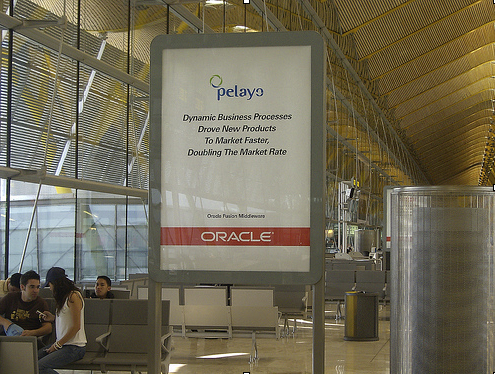Will Oracle answer these questions?

Tomorrow sees Oracle provide its Q4 results. I have no more insight into what those numbers will look like than anyone else but if past history is anything to go by, they'll likely be 'dramatic.'
More dramatic for me though will be insights into two areas: pricing and marketing. When I was in Lisbon last week, Karen Tillman, who is formulating the OpenWorld blogger program asked what I'm interested in getting deeper insights into from Oracle's execs. To start: How is Oracle going to sustain its c.33% operating margins (or 39% if you strip out amortization of intangibles and acquired assets) in a business which isn't really innovating and which is looking increasingly like a financial services business? Her eyes rolled as if to signal 'Oh no' but once the answer to that one is out the bag then a lot of questions follow. Perhaps the answer is self evident.
I see assertions that Oracle has cranked up the price list for its products by 15-20%. I have no way of testing that assertion because direct comparison is very difficult. Here is the current price list. Here is the comparison site offered. As you can see, Oracle's descriptions don't exactly match up with those from the reseller. More intriguing though is the fact that Oracle chose not to comment on the story. If true then as one of my colleagues said: 'Ballsy in a recession.' Maybe one of the financial analysts will ask the question: "We are seeing reports that the current price list represents a price hike of 15-20% True or false."
Then I see Judith Sim has been effusive throwing out numbers for Oracle marketing spend, saying it has fallen from 5% to 1.7% of revenue generated over the last decade adding in the totally predictable: "Oracle believes in doing more with less."
Let's test that assertion. In fiscal 1997, total revenue was $5.7 billion with sales and marketing running at $2.0 billion or around 35%. Fiscal 2007, the last year for which we can make a direct full year comparison saw total revenue at $18 billion and M&S cost at $3.9 billion or 21.6%. A creditable performance you might think. If you work out the absolute marketing figures based on these numbers then it turns out that Oracle is actually spending more on marketing: $306 million compared to $253 million. That however doesn't factor inflationary elements.
Looking more closely at Sims analysis, we see that: "It is also increasing its airport advertising, which this year makes up 29% of its total ad budget, up from 18% last year." I had to giggle at that one. When I presented at Lisbon, I showed a photo I had taken at Madrid Barajas airport (reproduced at the top of this article) as an example of wasted marketing spend. The reason it is wasted is because at least 90% of the people passing through that airport don't speak English and yet at the time, the airport was plastered with similar adverts. All in English. It may be hard to believe but I had not seen the B@B post from which I'm sourcing my numbers, which makes my observation to Oracle marketers all the more poignant.
But back to my original question. When you look at the 10 year vector in new software licenses compared to updates and support, we find that new have advanced from $2.8 billion to $5.9 billion or 210% while update and support revenue has ballooned from $1.3 billion to $8.3 billion or 638%. All that despite quadrupling R&D in the same period which lends strong weight to Bob Warfield's argument:
Consider the issues of supporting multiple platforms and versions of the software. I’ve chatted on several occassions with peers of mine who’ve done duty for both SaaS and conventional product development organizations. We’ve tried to estimate what the cost of supporting multiple platforms and versions is for the typical Enterprise Software R&D budget. The results are surprising. I routinely hear 30-40% of cycles are expended in these areas.
Imagine boiling off 40% of your available cycles for innovation just supporting old releases and doing platform work.
If Bob's ball park figures are correct, then it only requires a shaving of a relatively small number: say 5% off the support and maintenance top line figure to 17% rather than the listed 22% for Oracle's earnings to plunge by $1.9 billion because the R&D cost cannot go away that quickly. If anything, Bob's 30-40% could rise. That trauma won't happen anytime soon but it absolutely is not beyond the realms of possibility if service organizations like RiminiStreet and others can crank the services handle and take advantage of the alleged price hike and so attack Oracle's margins.
Let's tie the strands together. If as Sim says, marketing is only 1.7% of the total S&M figure then assuming that at least 80% of the sales figure relates to new sales, then we start to see some interesting impacts. Bringing the numbers up to date (ie to Q3 Fiscal 2008) new sales for the year totaled $4.3 billion. S&M amounted to $3.1 billion. That suggests to me it costs Oracle 64 cents on the dollar in sales costs to clinch each deal which in turn hooks the customer into those lucrative maintenance contracts.
So my follow up question for the Wall Street analysts would be: "The apparent list price hike suggests that software revenue license margins are under pressure. What will Oracle do if those same pressures are applied to the maintenance and support costs you charge those same customers?"
I'll return to this topic after the earnings announcement.
